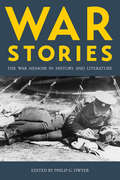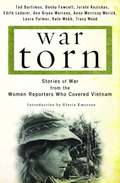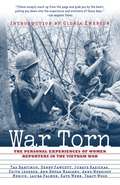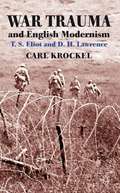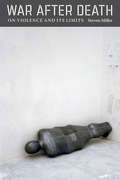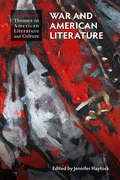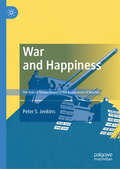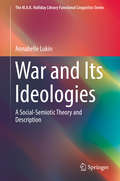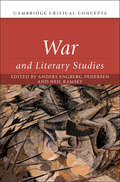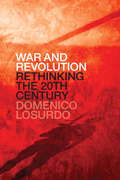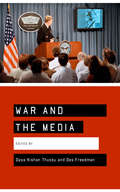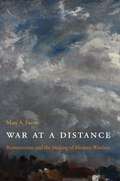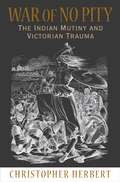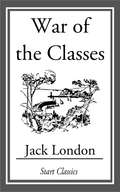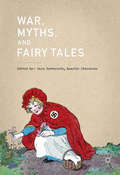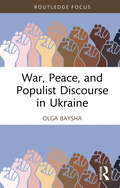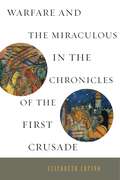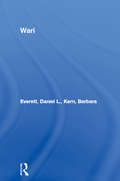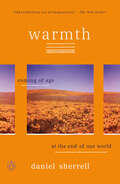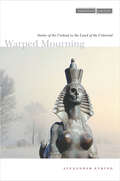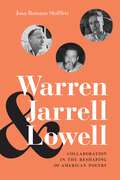- Table View
- List View
War Slang: American Fighting Words & Phrases Since the Civil War, Third Edition
by Paul DicksonFrom the homegrown "boodle" of the 19th century to current "misunderstandistan" in the Middle East, America's foremost expert on slang reveals military lingo at its most colorful, innovative, brutal, and ironic. Author Paul Dickson introduces some of the "new words and phrases born of conflict, boredom, good humor, bad food, new technology, and the pure horror of war." This newly updated reference extends to the post-9/11 world and the American military presence in Iraq and Afghanistan. Recommended by William Safire in his "On Language" column of The New York Times, it features dictionary-style entries, arranged chronologically by conflict, with helpful introductions to each section and an index for convenient reference. "Paul Dickson is a national treasure who deserves a wide audience," declared Library Journal. The author of more than 50 books, Dickson has written extensively on language. This expanded edition of War Slang features new material by journalist Ben Lando, Iraq Bureau Chief for Iraq Oil Report and a regular contributor to The Wall Street Journal and Time. It serves language lovers and military historians alike by adding an eloquent new dimension to our understanding of war.
War Stories: The War Memoir in History and Literature
by Philip DwyerAlthough war memoirs constitute a rich, varied literary form, they are often dismissed by historians as unreliable. This collection of essays is one of the first to explore the modern war memoir, revealing the genre’s surprising capacity for breadth and sophistication while remaining sensitive to the challenges it poses for scholars. Covering conflicts from the Napoleonic era to today, the studies gathered here consider how memoirs have been used to transmit particular views of war even as they have emerged within specific social and political contexts.
War Torn
by Tad Bartimus Denby Fawcett Jurate Kazickas Edith Lederer Ann MarianoFor the first time, nine women who made journalism history talk candidly about their professional and deeply personal experiences as young reporters who lived, worked, and loved surrounded by war. Their stories span a decade of America's involvement in Vietnam, from the earliest days of the conflict until the last U.S. helicopters left Saigon in 1975. They were gutsy risk-takers who saw firsthand what most Americans knew only from their morning newspapers or the evening news. Many had very particular reasons for going to Vietnam--some had to fight and plead to go--but others ended up there by accident. What happened to them was remarkable and important by any standard. Their lives became exciting beyond anything they had ever imagined, and the experience never left them. It was dangerous--one was wounded, and one was captured by the North Vietnamese--but the challenges they faced were uniquely rewarding.They lived at full tilt, making an impact on all the people around them, from the orphan children in the streets to their fellow journalists and photographers to the soldiers they met and lived with in the field. They experienced anguish and heartbreak--and an abundance of friendship and love. These stories not only introduce a remarkable group of individuals but give an entirely new perspective on the most controversial conflict in our history. Vietnam changed their lives forever. Here they tell about it with all the candor, commitment, and energy that characterized their courageous reporting during the war.From the Hardcover edition.
War Torn: The Personal Experiences of Women Reporters in the Vietnam War
by Laura Palmer Tad Bartimus Denby Fawcett Jurate Kazickas Edith Lederer Ann Mariano Anne Morrissy Merick Kate Webb Tracy WoodThis book is about our experiences as women reporters covering the Vietnam War from 1966 until the fall of Saigon in 1975. Each of us has written a chapter about what we saw and felt in Indochina--our adventures, fears, excitement, and the difficulties and loneliness. Vietnam was a unique war for all journalists, because there was no censorship. The U.S. military provided extraordinary access to combat operations. We could fly on bombing missions, parachute into hostile territory with an airborne unit, spend a week with the Special Forces in the jungle, hitch a ride on a chopper and land amid rocket and artillery as a battle raged, or be taken prisoner like a soldier. This access gave women reporters a chance to show that they could cover combat bravely and honorably, holding their own even under the most frightening and stressful circumstances.
War Trauma and English Modernism
by Carl KrockelThis is the first book to consistently read English Modernist literature as testimony to trauma of the First and Second World Wars. Focusing upon T. S. Eliot and D. H. Lawrence, it examines the impact of war upon their lives and their strategies to resist it through literary innovation.
War after Death: On Violence and Its Limits
by Steven MillerWar after Death considers forms of violence that regularly occur in actual wars but do not often factor into the stories we tell about war, which revolve invariably around killing and death. Recent history demonstrates that body counts are more necessary than ever, but the fact remains that war and death is only part of the story—an essential but ultimately subordinate part. Beyond killing, there is no war without attacks upon the built environment, ecosystems, personal property, artworks, archives, and intangible traditions.Destructive as it may be, such violence is difficult to classify because it does not pose a grave threat to human lives. Nonetheless, the book argues that destruction of the nonhuman or nonliving is a constitutive dimension of all violence—especially forms of extreme violence against the living such as torture and rape; and it examines how the language and practice of war are transformed when this dimension is taken into account.Finally, War after Death offers a rethinking of psychoanalytic approaches to war and the theory of the death drive that underlies them.
War and American Literature (Cambridge Themes in American Literature and Culture)
by Jennifer HaytockThis book examines representations of war throughout American literary history, providing a firm grounding in established criticism and opening up new lines of inquiry. Readers will find accessible yet sophisticated essays that lay out key questions and scholarship in the field. War and American Literature provides a comprehensive synthesis of the literature and scholarship of US war writing, illuminates how themes, texts, and authors resonate across time and wars, and provides multiple contexts in which texts and a war's literature can be framed. By focusing on American war writing, from the wars with the Native Americans and the Revolutionary War to the recent wars in Iraq and Afghanistan, this volume illuminates the unique role representations of war have in the US imagination.
War and Happiness: The Role of Temperament in the Assessment of Resolve
by Peter S. Jenkins“Jenkins’ rare combination of psychological theorizing and archival research in several countries and time periods yields a fascinating new take on the central question of when states over-estimate or under-estimate others’ resolve. The biases that leaders and elites fall prey to appear to vary with their emotional states and senses of well-being, factors that most scholars have ignored.”—Robert Jervis, author of How Statesmen ThinkThis groundbreaking book explains how the happiness levels of leaders, politicians and diplomats affect their assessments of the resolve of their state’s adversaries and allies. Its innovative methodology includes case studies of the origins of twelve wars with Anglo-American involvement from 1853 to 2003 and the psycholinguistic text mining of the British Hansard and the U.S. Congressional Record.
War and Its Ideologies: A Social-Semiotic Theory and Description (The M.A.K. Halliday Library Functional Linguistics Series)
by Annabelle LukinIdeology is so powerful it makes us believe that war is rational, despite both its brutal means and its devastating ends. The power of ideology comes from its intimate relation to language: ideology recruits all semiotic modalities, but language is its engine-room. Drawing on Halliday’s linguistic theory – in particular, his account of the “semiotic big-bang” - this book explains the latent semiotic machinery of language on which ideology depends. The book illustrates the ideological power of language through a study of perhaps the most significant and consequential of our ideologies: those that enable us to legitimate, celebrate, even venerate war, at the same time that we abhor, denounce and proscribe violence. To do so, it makes use of large multi-register corpora (including the British National Corpus), and the reporting of the 2003 invasion of Iraq by Australian, US, European, and Asian news sources. Combining detailed text analysis with corpus linguistic methods, it provides an empirical analysis showing the astonishing reach of our ideologies of war and their profoundly covert and coercive power.
War and Literary Studies (Cambridge Critical Concepts)
by Anders Engberg-Pedersen Neil RamseyWar and Literary Studies poses two main questions: First, how has war shaped the field of literary studies? And second, when scholars today study the literature of war what are the key concepts in play? Seeking to complement the extant scholarship, this volume adopts a wider and more systematic approach as it directs our attention to the relation between warfare and literary studies as a field of knowledge. What are the key characteristics of the language of war? Of gender in war? Which questions are central to the way we engage with war and trauma or war and sensation? In which ways were prominent 20th century theories such as critical theory, French postwar theory, postcolonial theory shaped by war? How might emergent concepts such as 'revolution,' 'the anthropocene' or 'capitalism' inflect the study of war and literature?
War and Peace (SparkNotes Literature Guide Series)
by SparkNotesWar and Peace (SparkNotes Literature Guide) by Leo Tolstoy Making the reading experience fun! Created by Harvard students for students everywhere, SparkNotes is a new breed of study guide: smarter, better, faster. Geared to what today's students need to know, SparkNotes provides: *Chapter-by-chapter analysis *Explanations of key themes, motifs, and symbols *A review quiz and essay topicsLively and accessible, these guides are perfect for late-night studying and writing papers
War and Revolution
by Domenico LosurdoWar and Revolution identifies and takes to task a reactionary trend among contemporary historians, one that's grown increasingly apparent in recent years. It's a revisionist tendency discernible in the work of authors such as Ernst Nolte, who traces the impetus behind the Holocaust to the excesses of the Russian Revolution; or François Furet, who links the Stalinist purges to an "illness" originating with the French Revolution. The intention of these revisionists is to eradicate the revolutionary tradition. Their true motives have little to do with the quest for a greater understanding of the past, but lie in the climate of the present day and the ideological needs of the political classes, as is most clearly seen now in the work of the Anglophone imperial revivalists Paul Johnson and Niall Ferguson. In this vigorous riposte to those who would denigrate the history of emancipatory struggle, Losurdo captivates the reader with a tour de force account of modern revolt, providing a new perspective on the English, American, French and twentieth-century revolutions.From the Hardcover edition.
War and the Media: Reporting Conflict 24/7
by Des Freedman Daya Kishan Thussu`No book is more timely than this collection, which analyses brilliantly the Western media's relentless absorption into the designs of dominant, rapacious power' - John Pilger `A most timely book, with many valuable insights' - Martin Bell O.B.E `It has long been known that the outcome of war is deeply influenced by the battle to win 'hearts and minds'. This book provides a stimulating set of perspectives which combine the analyses of prominent academics with the experiences of leading journalists' - Professor Tom Woodhouse, University of Bradford `This volume represents an all-star cast of authors who have a tremendous amount of knowledge about media and world conflict. One of its strengths is that it doesn't focus entirely narrowly on media, but puts the discussion of media issues in the context of changes in the world order in military doctrine' - Professor Daniel C. Hallin, University of California `This book comes just in time. A coherent and wide-ranging collection of data, analyses and insights that help our understanding of the complex interaction between communication and conflict. A major intellectual contribution to critical thinking about the early 21st century' - Cees J Hamelink, Professor International Communication, University of Amsterdam With what new tools do governments manage the news in order to prepare us for conflict? Are the media responsible for turning conflict into infotainment? Is reporting gender specific? How do journalists view their role in covering distant wars? This book critically examines the changing contours of media coverage of war and considers the complexity of the relationship between mass media and governments in wartime. Assessing how far the political, cultural and professional contexts of media coverage have been affected by 9/11 and its aftermath, the volume also explores media representations of the `War on Terrorism' from regional and international perspectives, including new actors such as the Qatar-based Al-Jazeera - the pan-Arabic television network. One key theme of the book is how new information and communication technologies are influencing the production, distribution and reception of media messages. In an age of instant global communication and round-the-clock news, powerful governments have refined their public relations machinery, particularly in the way warfare is covered on television, to market their version of events effectively to their domestic as well as international viewing public. Transnational in its intellectual scope and in perspectives, War and the Media includes essays from internationally known academics along with contributions from media professionals working for leading broadcasters such as BBC World and CNN.
War at a Distance: Romanticism and the Making of Modern Wartime
by Mary A. FavretWhat does it mean to live during wartime away from the battle zone? What is it like for citizens to go about daily routines while their country sends soldiers to kill and be killed across the globe? Timely and thought-provoking, War at a Distance considers how those left on the home front register wars and wartime in their everyday lives, particularly when military conflict remains removed from immediate perception, available only through media forms. Looking back over two centuries, Mary Favret locates the origins of modern wartime in the Napoleonic era and describes how global military operations affected the British populace, as the nation's army and navy waged battles far from home for decades. She reveals that the literature and art produced in Britain during the late eighteenth and early nineteenth centuries obsessively cultivated means for feeling as much as understanding such wars, and established forms still relevant today. Favret examines wartime literature and art as varied as meditations on the Iliad, the history of meteorology, landscape painting in India, and popular poetry in newspapers and periodicals; she locates the embedded sense of war and dislocation in works ranging from Austen, Coleridge, and Wordsworth to Woolf, Stevens, and Sebald; and she contemplates how literature provides the public with methods for responding to violent calamities happening elsewhere. Bringing to light Romanticism's legacy in reflections on modern warfare, this book shows that war's absent presence affects home in deep and irrevocable ways.
War of No Pity: The Indian Mutiny and Victorian Trauma
by Christopher HerbertOn May 11, 1857, Hindu and Muslim sepoys massacred British residents and native Christians in Delhi, setting off both the whirlwind of similar violence that engulfed Bengal in the following months and an answering wave of rhetorical violence in Britain, where the uprising against British rule in India was often portrayed as a clash of civilization and barbarity demanding merciless retribution. Although by twentieth-century standards the number of victims was small, the Victorian public saw "the Indian Mutiny" of 1857-59 as an epochal event. In this provocative book, Christopher Herbert seeks to discover why. He offers a view of this episode--and of Victorian imperialist culture more generally--sharply at odds with the standard formulations of postcolonial scholarship. Drawing on a wealth of largely overlooked and often mesmerizing nineteenth-century texts, including memoirs, histories, letters, works of journalism, and novels, War of No Pity shows that the startling ferocity of the conflict in India provoked a crisis of national conscience and a series of searing if often painfully ambivalent condemnations of British actions in India both prior to and during the war. Bringing to light the dissident, disillusioned, antipatriotic strain of Victorian "mutiny writing," Herbert locates in it key forerunners of modern-day antiwar literature and the modern critique of racism.
War of Words: Language, Politics and 9/11
by Sandra SilbersteinIn a media age, wars are waged not only with bombs and planes but also with video and sound bites. War of Words is an incisive report from the linguistic battlefields, probing the tales told about September 11th to show how Americans created consensus in the face of terror. Capturing the campaigns for America's hearts, minds, wallets and votes, Silberstein traces the key cultural conflicts that surfaced after the attacks and beyond: the attacks on critical intellectuals for their perceived 'blame America first' attitude the symbiotic relationship between terrorists and the media (mis)representations of Al Qaeda and the Taliban used to justify military action the commercialisation of September 11th news as 'entertainment' when covering tragic events. Now featuring a new chapter on the Second Anniversary and Beyond, including: the war in Iraq, the backlash against former 'heroes' and accusations of presidential mendacity.A perceptive and disturbing account, War of Words reveals the role of the media in manufacturing events and illuminates the shifting sands of American collective identity in the post September 11th world.
War of the Classes
by Jack LondonThe class struggle -- The tramp -- The scab -- The question of the maximum -- A review -- Wanted: a new law of development -- How I became a socialist
War, Genocide, and Justice: Cambodian American Memory Work
by Cathy J. Schlund-VialsIn the three years, eight months, and twenty days of the Khmer Rouge&’s deadly reign over Cambodia, an estimated 1.7 million Cambodians perished as a result of forced labor, execution, starvation, and disease. Despite the passage of more than thirty years, two regime shifts, and a contested U.N. intervention, only one former Khmer Rouge official has been successfully tried and sentenced for crimes against humanity in an international court of law to date. It is against this background of war, genocide, and denied justice that Cathy J. Schlund-Vials explores the work of 1.5-generation Cambodian American artists and writers.Drawing on what James Young labels &“memory work&”—the collected articulation of large-scale human loss—War, Genocide, and Justice investigates the remembrance work of Cambodian American cultural producers through film, memoir, and music. Schlund-Vials includes interviews with artists such as Anida Yoeu Ali, praCh Ly, Sambath Hy, and Socheata Poeuv. Alongside the enduring legacy of the Killing Fields and post-9/11 deportations of Cambodian American youth, artists potently reimagine alternative sites for memorialization, reclamation, and justice. Traversing borders, these artists generate forms of genocidal remembrance that combat amnesic politics and revise citizenship practices in the United States and Cambodia.Engaged in politicized acts of resistance, individually produced and communally consumed, Cambodian American memory work represents a significant and previously unexamined site of Asian American critique.
War, Myths, and Fairy Tales
by Maartje Abbenhuis Sara ButtsworthThis exciting new collection examines the relationships between warfare, myths and fairy tales, and explores the connections and contradictions between the narratives of war and magic that dominate the ways in which people live and have lived, survived, considered and described their world. Presenting original contributions and critical reflections that explore fairy tales, fantasy and wars, be they 'real' or imagined, past or present, this book looks at creative works in popular culture, stories of resistance, the history and representation of global and local conflicts, the Holocaust, across multiple media. It offers a timely and important overview of the latest research in the field, including contributions from academics, story-tellers and artists, thereby transcending the traditional boundaries of the disciplines, extending the parameters of war studies beyond the battlefield.
War, Peace, and Populist Discourse in Ukraine (Routledge Focus on Communication Studies)
by Olga BayshaThis book explores the detrimental effects on global peace of populism’s tendency to present complex social issues in simplistic "good versus evil" terms. Analyzing the civilizational discourse of Ukrainian President Volodymyr Zelensky with respect to the ongoing war between Russia and Ukraine—with his division of the world into "civilized us" versus "barbarian them"—the book argues that such a one-dimensional representation of complex social reality leaves no space for understanding the conflict and has little, if any, potential to bring about peace.To deconstruct the "civilization versus barbarism" discourse propagated by Zelensky, the book incorporates into its analysis alternative articulations of the crisis by oppositional voices. The author looks at the writing of several popular Ukrainian journalists and bloggers who have been excluded from the field of political representation within Ukraine, where all oppositional media are currently banned. Drawing on the discourse theory of Ernesto Laclau and Chantal Mouffe, the author argues that the incorporation of alternative perspectives, and silenced voices, is vitally important for understanding the complexity of all international conflicts, including the current one between Russia and Ukraine.This timely and important study will be relevant for all students and scholars of media and communication studies, populist rhetoric, political communication, journalism, area studies, international relations, linguistics, discourse analysis, propaganda, and peace studies.
Warfare and the Miraculous in the Chronicles of the First Crusade
by Elizabeth LapinaIn Warfare and the Miraculous in the Chronicles of the First Crusade, Elizabeth Lapina examines a variety of these chronicles, written both by participants in the crusade and by those who stayed behind. Her goal is to understand the enterprise from the perspective of its contemporaries and near contemporaries. Lapina analyzes the diversity of ways in which the chroniclers tried to justify the First Crusade as a “holy war,” where physical violence could be not just sinless, but salvific. The book focuses on accounts of miracles reported to have happened in the course of the crusade, especially the miracle of the intervention of saints in the Battle of Antioch. Lapina shows why and how chroniclers used these miracles to provide historical precedent and to reconcile the messiness of history with the conviction that history was ordered by divine will. In doing so, she provides an important glimpse into the intellectual efforts of the chronicles and their authors, illuminating their perspectives toward the concepts of history, salvation, and the East. Warfare and the Miraculous in the Chronicles of the First Crusade demonstrates how these narratives sought to position the crusade as an event in the time line of sacred history. Lapina offers original insights into the effects of the crusade on the Western imaginary as well as how medieval authors thought about and represented history.
Wari (Descriptive Grammars)
by Daniel L. Everett Barbara KernThis is the first major study of any Chapakuran language and makes an important contribution to linguistic theory. This study is especially timely as the Chapakuran languages of Western Brazil and Eastern Bolivia are endangered, and less than 2,000 known speakers of Wari and its related dialects are left in existence.
Warmth: Coming of Age at the End of Our World
by Daniel SherrellFrom a millennial climate activist, an exploration of how young people live in the shadow of catastrophe&“Strikingly perceptive.&” —Jenny Offill, author of Weather &“Beautifully rendered and bracingly honest.&” —Jenny Odell, author of How to Do NothingWarmth is a new kind of book about climate change: not what it is or how we solve it, but how it feels to imagine a future--and a family--under its weight. In a fiercely personal account written from inside the climate movement, Sherrell lays bare how the crisis is transforming our relationships to time, to hope, and to each other. At once a memoir, a love letter, and an electric work of criticism, Warmth goes to the heart of the defining question of our time: how do we go on in a world that may not?
Warped Mourning: Stories of the Undead in the Land of the Unburied (Cultural Memory in the Present)
by Alexander EtkindAfter Stalin's death in 1953, the Soviet Union dismantled the enormous system of terror and torture that he had created. But there has never been any Russian ban on former party functionaries, nor any external authority to dispense justice. Memorials to the Soviet victims are inadequate, and their families have received no significant compensation. This book's premise is that late Soviet and post-Soviet culture, haunted by its past, has produced a unique set of memorial practices. More than twenty years after the collapse of the Soviet Union, Russia remains "the land of the unburied": the events of the mid-twentieth century are still very much alive, and still contentious. Alexander Etkind shows how post-Soviet Russia has turned the painful process of mastering the past into an important part of its political present.
Warren, Jarrell, and Lowell: Collaboration in the Reshaping of American Poetry
by Joan Romano ShifflettRobert Penn Warren, Randall Jarrell, and Robert Lowell maintained lifelong, well-documented friendships with one another, often discussing each other’s work in private correspondence and published reviews. Joan Romano Shifflett’s Warren, Jarrell, and Lowell: Collaboration in the Reshaping of American Poetry traces the artistic and personal connections between the three writers. Her study uncovers the significance of their parallel literary development and reevaluates dominant views of how American poetry evolved during the mid-twentieth century. Familiar accounts of literary history, most prominently the celebration of Lowell’s Life Studies as a revolutionary breakthrough into confessional poetry, have obscured the significance of the deep connections that Lowell shared with Warren and Jarrell. They all became quite close in the 1930s, with the content and style of their early poetry revealing the impact of their mentors John Crowe Ransom and Allen Tate, whose aesthetics the three would ultimately modify and transform. The three poets achieved professional maturity and success in the 1940s, during which time they relied on one another’s honest critiques as they experimented with changes in subject matter and modes of expression. Shifflett shows that their works of the late 1940s were heavily influenced by Robert Frost. This period found Warren, Jarrell, and Lowell infusing ostensibly simple verse with multifaceted layers of meaning, capturing the language of speech in diction and rhythm, and striving to raise human experience to a universal level. During the 1950s, the three poets became public figures, producing major works that addressed the nation’s postwar need to reconnect with humanity. Warren, Jarrell, and Lowell continued to respond in interlocking ways throughout the 1960s, with each writer using innovative stylistic techniques to create a colloquy with readers that directed attention away from superficial matters and toward the important work of self-reflection. Drawing from biographical materials and correspondence, along with detailed readings of many poems, Warren, Jarrell, and Lowell offers a compelling new perspective on the shaping of twentieth-century American poetry.

